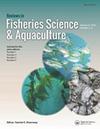Restocking Depleted Wild Stocks—Long-Term Survival and Impact of Released Blacklip Abalone (Haliotis rubra) on Depleted Wild Populations in New South Wales, Australia
引用次数: 8
Abstract
The potential for restocking with hatchery organisms as a tool to rebuild depleted populations of blacklip abalone (Haliotis rubra) was investigated through replicated, control-impact studies in New South Wales, Australia. Long-term survival (>2 years) of hatchery-reared and released abalone, their impact on wild abalone abundance, and the effect of diffuse versus concentrated release was investigated on natural reefs. Long-term survival of released hatchery abalone varied between releases but averaged about that expected for wild abalone. There was no significant effect of released juveniles on the persistence or recruitment of wild abalone. Significantly greater numbers of all (released and wild) abalone persisted at release locations through time, while the total number of wild abalone increased significantly through time at release and control locations. There was no significant difference in long-term survival of abalone released in clusters of high density (2–4%) or in a diffuse or concentrated array (0–9%). These results show that restocking can supplement natural rebuilding processes of depleted wild abalone populations in New South Wales, Australia.重新放养枯竭野生种群——释放黑唇鲍鱼对枯竭野生种群的长期生存和影响
通过在澳大利亚新南威尔士州进行的重复对照影响研究,对重新放养孵化场生物作为重建枯竭黑唇鲍鱼种群的工具的潜力进行了调查。研究了人工放养鲍鱼在自然礁上的长期生存(bb0 ~ 2年)、对野生鲍鱼丰度的影响以及分散放养和集中放养对野生鲍鱼丰度的影响。放生的孵化场鲍鱼的长期存活率因放生而异,但与野生鲍鱼的平均存活率大致相同。放生幼鱼对野生鲍鱼的存续和招募均无显著影响。随着时间的推移,所有(释放和野生)鲍鱼的数量在释放地点持续增加,而野生鲍鱼的总数在释放和控制地点随着时间的推移显着增加。以高密度放生(2-4%)或分散放生(0-9%)的鲍鱼长期存活率无显著差异。这些结果表明,在澳大利亚新南威尔士州,重新放养可以补充枯竭的野生鲍鱼种群的自然重建过程。
本文章由计算机程序翻译,如有差异,请以英文原文为准。
求助全文
约1分钟内获得全文
求助全文

 求助内容:
求助内容: 应助结果提醒方式:
应助结果提醒方式:


